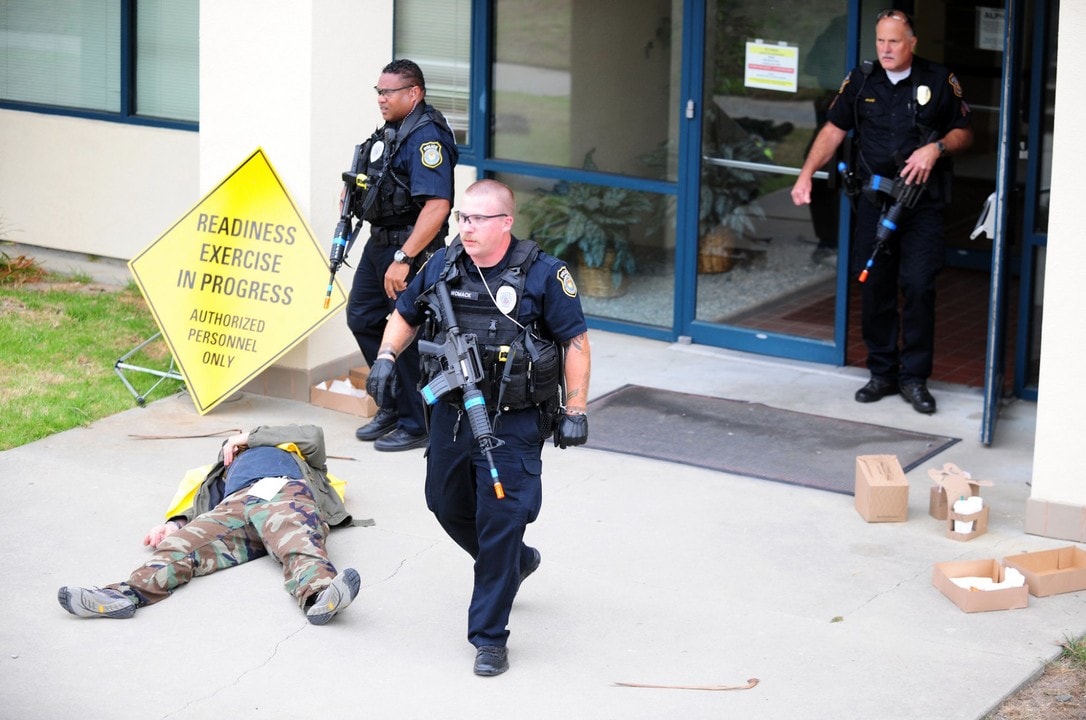
17 Oct ‘RUN, HIDE, FIGHT’ vs ‘MOVE! ESCAPE OR ATTACK’ – How Words Influence Mindset
The article by Mike Wood I posted a couple of weeks ago Why ‘Move, Escape, or Attack’ is superior to ‘Run, Hide, Fight’, generated a lot of interesting chatter. The feedback ran the gamut from “love it” to “same thing” to “hate it”. So many noteworthy opinions on the topic, it became almost impossible to respond to them all. But I would like to address the main points made by so many in our industry and why I found the article particularly interesting.
Does the verbiage really matter?
Absolutely! For two reasons;
1. Words influence mindset. If I told you that something was unlikely to ever happen, would you train differently than if you knew it to be a certainty. The word “if” has an entirely different connotation than the word “when”. Whether you are the victim of an attack or the survivor of one; it is your mindset which makes the determination. How you train and the verbiage used will impact that mindset; good or bad.
2. Security should not alter company culture. Agree with this or not it is a fact of Corporate America. A company’s culture is the heart of its people. As security professionals, if we do not make it our purpose to help keep their people safe in a way which works within their existing culture, we are all going to be out of a job. We are doomed to come in like Hurricane Matthew and make significant changes that fail within the first year. For lasting change, we need buy-in from everyone. That level of buy-in is only accomplished when the verbiage of the message is part of a strong, existing culture. The failure or success of a security initiative is determined by the people. While some companies are demanding something more than RHF, others are still hanging on to LOCKDOWN.
Why complicate the message by changing the words?
Talking about change does not complicate the message, rather it demonstrates a dedication to finding the best solution to a growing and ever changing threat. Every great invention and cure came from someone asking “How can this be better?”. It wasn’t too long ago that LOCKDOWN was considered the best response to an Active Shooter event, but we slowly began to see how that needed to evolve.
If a company is already utilizing RHF and it works for their culture, I am not suggesting they change to MEA. However, there are many companies who still have not heard of RHF regardless of how long it has been around. Others cannot fathom the thought of telling their employees to FIGHT and refuse to move beyond LOCKDOWN. For some, education will be enough to change their opinion; others will be swayed only when they are faced with the aftermath of an event.
Is there an industry standard/ should there be?
We do not have an industry standard for Active Shooter Response and frankly I do not believe it wise to create one. Response should be fluid like the attack and because the attacks are constantly evolving, so should our responses. Most importantly, the response isn’t just for the security industry. It has to be able to work in all industries and within the specific organizational culture.
The Department of Homeland Security has backed RHF but that does not make it a standard. Standards set by the government can often become stagnate and slow to change even when everything points to the need for it. Just ask anyone who has ever served in the military or held a government or state job.
Organizations should have a standard. Like all policies, the response adapted for an Active Shooter event should be the same in all facilities; varying only for facility layout. The idea of forcing a standard, whether it be from the safety industry or the government, is unwise.
Does MEA represent an evolution in active shooter response?
I believe it does represent an evolution but only to those who teach it that way. There will always be those who believe that MEA is no different than RHF. In which case, they will present it in such a way that is no different. I believe words impact mindset, influence how we think and react. It is how I choose to teach it. I do not offer it as an option to all of my clients. It is a rather aggressive response. My goal is always to understand the existing culture and make sure the response is something that can be embedded and supported long term.
Since being introduced to RHF in 2013, I have asked “What are the other options?” “What is being developed to better this process?” As an industry, we should all be asking these questions. These events gain a great deal of media coverage and unfortunately many copycat threats seeking that same notoriety. Where we used to see the shooter take their own life at the first sign of law enforcement, they are now barricading themselves, continuing to kill victims and shooting it out with first responders. The threats are evolving, shouldn’t our response?
Why I Believe MEA could be better?
RUN – The word alone denotes movement but I believe it may promote action without purpose. Think of Jurassic Park, when Laura Dern comes limping up the hill, saying “RUN” (https://youtu.be/hT2tAQluk0E). Her counterpart does run, towards her and towards the threat; even though she is running in the opposite direction. Yes, it should be understood that RUN means “away from the threat” but in an actual event, an employee may not understand where the threat is or take the time to assess his/her surroundings before blindly making for the first exit they can recall at that moment. It may not be the closest exit or the one furthest from the threat.
MOVE – This word requires some forethought. If someone tells you to move, the first thing you do is assess your surroundings and choose the best option. This is a split second decision. “I know I need to do something.” “Where am I in relation to the threat?” “Can I escape?” “Do I seek cover/concealment and if I do, what is my next move?” “What do I have to attack with?”
HIDE but leave a secondary exit. Yet in an office setting, very few interior rooms have secondary exits. If lucky, there might be a window and it might be on lower floor. That means if the employee is unable to secure the door well enough and the shooter/threat finds his way in, the only option is to fight.
Hiding is what the kids in Columbine did, Virginia Tech and more recently the Orlando night club. Unfortunately, too many people think hiding is the permanent solution. “I’ll hide under this table and tweet my goodbyes until he finds me.”
I have worked with companies who refused to allow this word anywhere near their Emergency Action Plan. The word, for them, holds a negative connotation. If ESCAPE is not an option, their people are taught to seek cover only until they can ESCAPE or ATTACK.
ESCAPE – This is movement with purpose. RUN but now you have a plan for your direction; a purpose for your movement.
FIGHT v ATTACK – One is defensive and the other is offensive. An employee knows the layout of the facility better than the attacker (unless the attacker is another employee). The attacker is already on the offense. He knew what he was going to do when he walked into the facility, maybe even before then. An employee has two options; have a plan and derail the attacker by being the resistance he hadn’t expected to encounter OR defend themselves when backed into a corner with no other options and maybe no plan.
In Conclusion
Whether you believe MEA is simply a new acronym for RHF or the evolution of it, the fact is it’s generating much needed conversation. I applaud any company willing to be proactive enough to get a plan in place and drill it; whether that be RUN HIDE FIGHT, MOVE ESCAPE ATTACK, MOVE OUT /HIDE OUT /TAKE OUT, ESCAPE/EVADE or the ever blunt but simple GFO.
The bottom line is that they are all worthless if the response is not actively taught, drilled and coached on a regular basis. Without the buy-in of the people and support of leadership; they are all just acronyms creating the same outcome……………victims.



Sorry, the comment form is closed at this time.